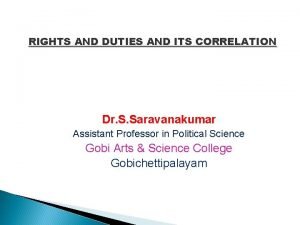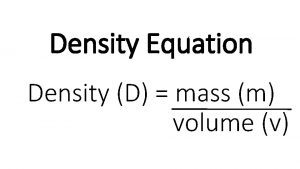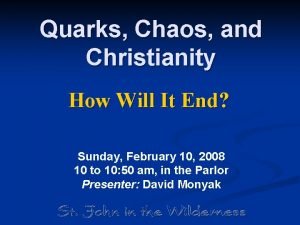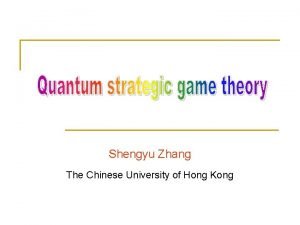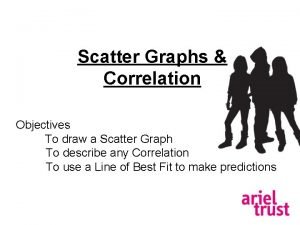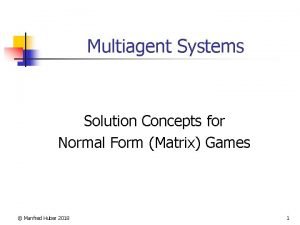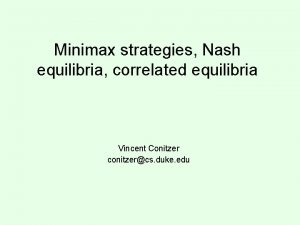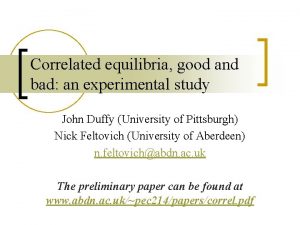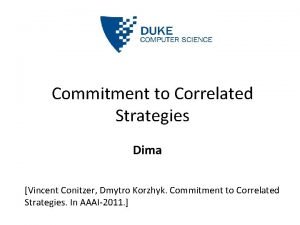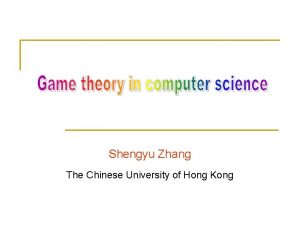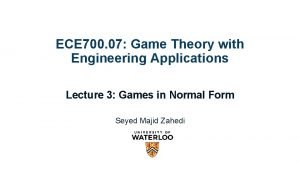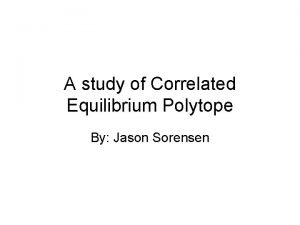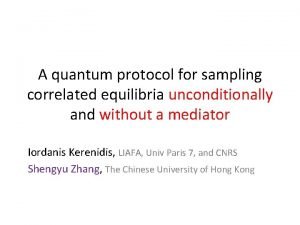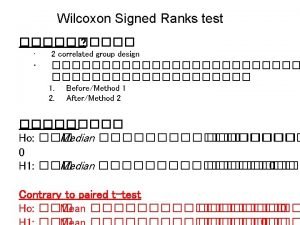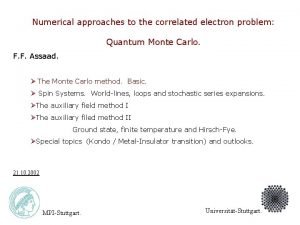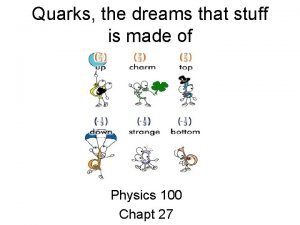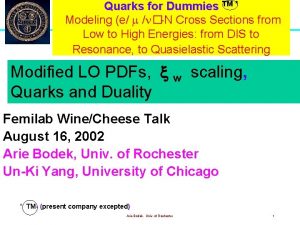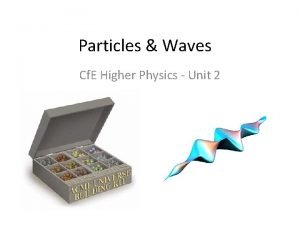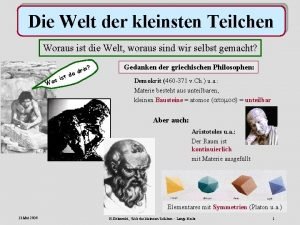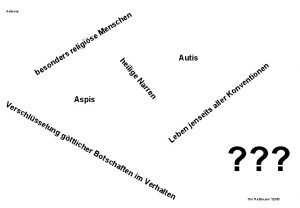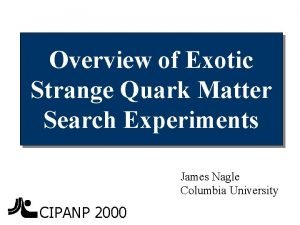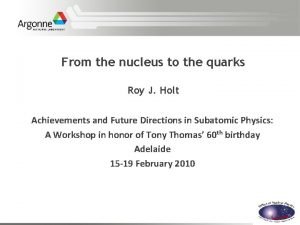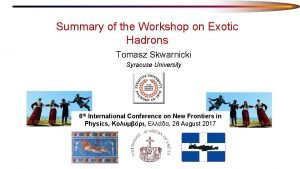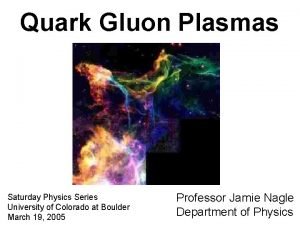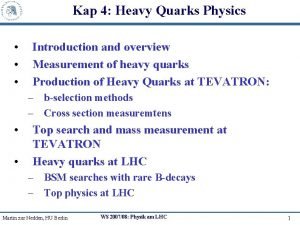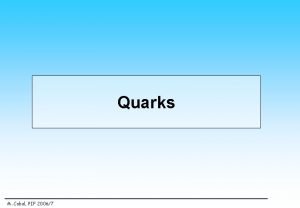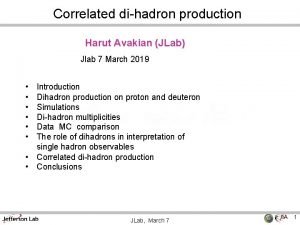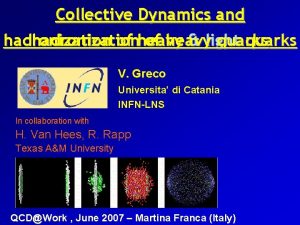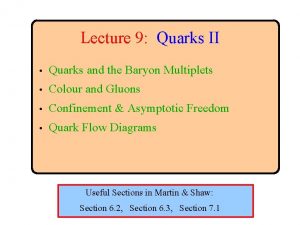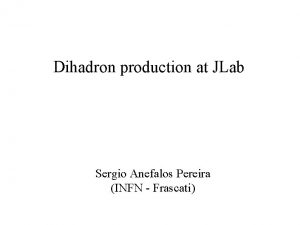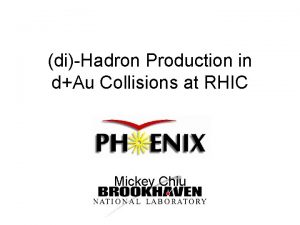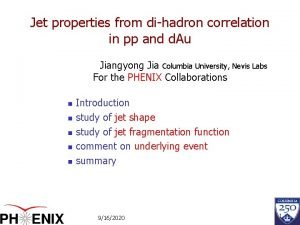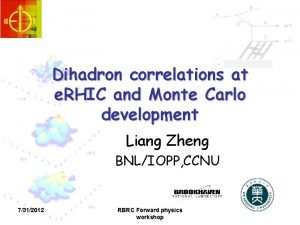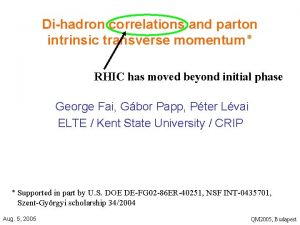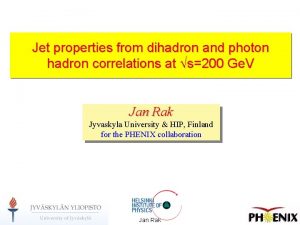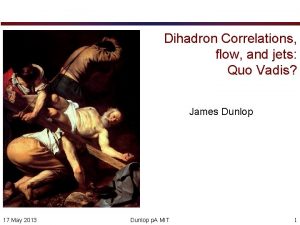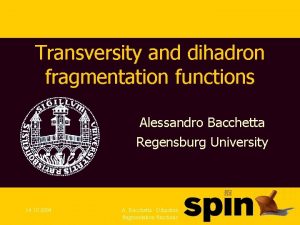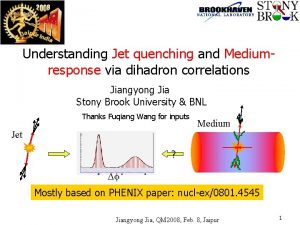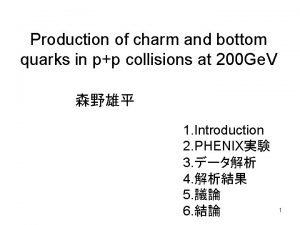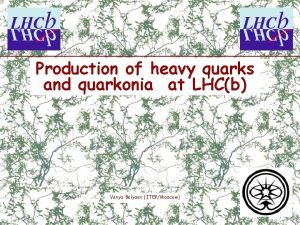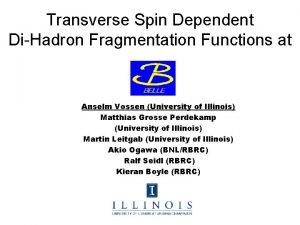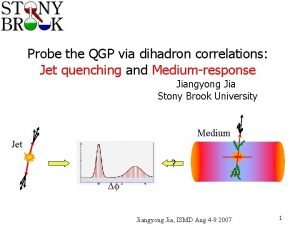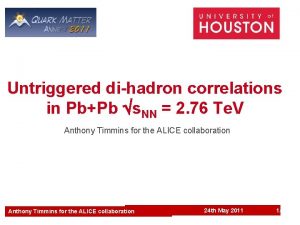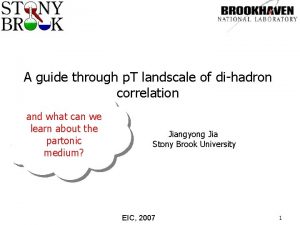Hadronization of quarks and correlated dihadron production in




























- Slides: 28

Hadronization of quarks and correlated di-hadron production in DIS Harut Avakian (JLab) DPANA meeting Sep 26, 2019 • • • Motivation: Hadronization of quarks and independent fragmentation Dihadron production at CLAS 12 • 2 pion channels • LUND MC vs data and tune for hadronization • e+e- decays of VM Conclusions H. Avakian, DNP, Oct 15 1

SIDIS kinematical plane and observables Polarised Target y m beam x z z EIC beam polarization target polarization corrections for the region of large k. T~Q H. Avakian, DNP, Oct 15 2

Transverse momentum dependence quark transverse momentum “q. T-crisis”: TMD based theory doesn’t work at large q. T, and perturbative QCD predicts much lower x-sections H. Avakian, DNP, Oct 15 3

Transverse momentum dependence COMPASS ep e’ p. X e+e- h. X In SIDIS and e+e- final state hadrons exhibit the same dependence on the transverse momentum, which looks like 2 Gausses, one <0. 8 Ge. V, second above 1 Ge. V Expectation: low PT TMDs, large PT perturbative H. Avakian, DNP, Oct 15 4

Extracting the average transverse momenta • • Adding DY data shifts up the values of transverse momenta Suggestion: perform fits for PT>0. 7 -0. 8 Ge. V, where independent fragmentation safer H. Avakian, DNP, Oct 15 5

CLAS 12 Detector Systems Forward Detector (FD) - TORUS magnet HT Cherenkov Counter Drift chamber system LT Cherenkov Counter Forward To. F System Pre-shower calorimeter E. M. calorimeter Forward Tagger RICH detector Central Detector (CD) - Solenoid magnet Silicon Vertex Tracker Central Time-of-Flight Central Neutron Detector Micro. Megas MM CND FT Beamline - Diagnostics - Shielding - Targets - Polarimeter - Faraday Cup Number of readout channels > 100, 000 RICH https: //www. jlab. org/Hall-B/clas 12 -web/ H. Avakian, DNP, Oct 15 6

CLAS 12 -Run Group A: ep e’p+p-X Filled circles low lumi data, filled squares high lumi data open symbols MC: circles 70% VM, squares 30% VM • Normalizing all sets to the same number of reconstructed electrons • e’p+p-X MC in good agreement CLAS 12 data H. Avakian, DNP, Oct 15 7

CLAS 12 -RGA: ep e’p+p-X Using low lumi 5 n. A RGA runs (filled circels) to tune the MC based on LUND Fragmentation Filled circles CLAS 12 open symbols MC: circles 70% VM, squares 50% VM CLAS 12 data MC comparison indicates: there is a very significant fraction of pions coming from VM decays PRELIMINARY low Mpp region may need increase of the fraction of VMs H. Avakian, DNP, Oct 15 8

RGA: ep e’p+p-X PRELIMINARY Filled circles CLAS 12 data, open symbols MC: circles 70% VM, squares 30% VM H. Avakian, DNP, Oct 15 9

PT distributions in the rho region PT- distributions of pions in the rho region look like Gaussian Inclusive p+/p-from r-region H. Avakian, DNP, Oct 15 10

PT of pions from rho decays: LUND string fragmentation Fraction of direct p+ increases with PT r 0 p+/p- PT-dependence of “direct” rho and pions wider than the one for decay pions Wider Gausses in pion distributions may be from “direct” pions H. Avakian, DNP, Oct 15 11

Does it matter if the pion comes from correlated pairs? quark transverse momentum q. T =PT/ zr Q 2>2 perturbative? q. T=PT/ zp The measurements disagree with leading order and next-toleading order calculations most significantly at the more moderate understanding the fraction of pions from values of x close to the valence region. “correlated dihadrons” will be important to Gonzalez-Hernandez et al, PRD 98, 114005 (2018) make sense out of q. T distributions H. Avakian, DNP, Oct 15 12

Using e+e- to estimate vector mesons The invariant mass of dihadrons is contaminated by other vector mesons, with shape not changing significantly with hadronization fraction to spin-1 vs spin-0 mesons p 0 h decays of p and h are kinematically separeated from w and r 0 p 0 ge+e- 1. 10 -2 h ge+e- 7. 10 -3 r e+e- 4. 72+/-0. 05 10 -5 w e+e- 7. 36+/-0. 15 10 -5 f e+e- 2. 97+/-0. 15 10 -4 r w Vector meson per electron can be independently estimated from ep e’e+e-X Significant fraction of VM may affect DY studies. H. Avakian, DPANA, Sep 26 13

SUMMARY • The CLAS 12 data supports predictions from different MCs of very significant fraction of inclusive pions coming from correlated dihadrons (supported by latest e+e- studies). • Higher fraction of hadrons with spin-1 vs spin-0 in hadronization will have a number of implications • The observables for pions from rhos have peculiar spin and momentum dependences and may require different RC, modeling, and interpretation • Understanding of exclusive production of hadrons, in particular, at large t, where they show similar behavior, will be important for SIDIS The interpretation of di-hadron production in SIDIS, as well as interpretation of single-hadron production, the independent fragmentation, in particular, are intimately related to contributions to those samples from correlated semi-inclusive and exclusive di-hadrons in general, and rho mesons, in particular. H. Avakian, DNP, Oct 15 14

Support slides H. Avakian, DNP, Oct 15 15

RGA: ep e’p+p-X PRELIMINARY Filled circles low lumi data, filled squares high lumi data open symbols MC: circles 70% VM, squares 50% VM H. Avakian, DNP, Oct 15 16

Tuning the LUND-MC Should describe in the full kinematical range both: • the inclusive pions (all flavors) • the di-hadron multiplicities (all combinations) Filled circles low lumi data, open symbols MC: circles 70% VM CLASDIS, squares 70% VM PYTHIA H. Avakian, DNP, Oct 15 17

CLAS 12 -Run Group A: ep e’p+p-X Filled circles low lumi data, filled squares high lumi data open symbols MC: circles 70% VM, squares 30% VM Normalizing all sets to the same number of reconstructed electrons x, Q 2 -dependences for e’p+p-X MC (line) in good agreement with low lumi data H. Avakian, DNP, Oct 15 18

PT of pions from rho decays: LUND string fragmentation z>0. 5 z>0. 4 z>0. 3 z>0. 2 z>0. 1 Fraction of direct p+ increases with PT Fraction of direct p+ decreases with PT/z/Q H. Avakian, DNP, Oct 15 19

Tuning the LUND-MC: dihadrons Should describe in the full kinematical range both: • the inclusive pions (all flavors) • the di-hadron multiplicities (all combinations) PRELIMINARY Filled circles low lumi data, open symbols MC: circles 70% VM CLASDIS, squares 70% VM PYTHIA H. Avakian, DNP, Oct 15 20

PT-widths Using low lumi 5 n. A RGA runs 5418, 5419 p+ p+p- For the same <z> the transverse width of rho (p+p-) is wider than p+ H. Avakian, DNP, Oct 15 21

Invariant mass distributions for 2 p+ All events with parent of p+ is r 0 CLAS 12 MC CLAS 12 data Mp+p- second p+ Mp+p+ The p+/p- pairs out of r-region may still be generated by rs H. Avakian, DNP, Oct 15 22

Correlated hadron production: Where it matters • CLAS 12 data supports predictions from different MCs a very significant fraction of inclusive pions coming from correlated dihadrons (large VM fraction supported by latest e+e- studies). • Most pions coming from VM decays will change: • number of e+e-/m+m- pairs produced in hadronization process (may be relevant for DY) • account of radiative corrections will require a different set of SFs (exclusive VMs may contribute) • modeling of spin effects will be different (opposite sign for Collins predicted) • interpretation has to account lower PT/z in case z=Eh/n involves the energy of rho instead of pion • Analysis of SIDIS involving direct pions may require higher PT, where direct pions dominate the single pion sample. H. Avakian, DNP, Oct 15 23

e+e- distributions in ep e’ e+e-X Meson-decay electron energy distribution messed up H. Avakian, DNP, Oct 15 24

VM contributions: MC vs Data Timothy B. Hayward W&M The 70% contribution much more closely matches the data. H. Avakian, DNP, Oct 15 25

H. Avakian, DNP, Oct 15 26

compare different distributions: 70% vs 50% 70% H. Avakian, DNP, Oct 15 27

compare different distributions: clasdis vs claspyth 70% claspyth clasdis H. Avakian, DNP, Oct 15 28
 Post produksi
Post produksi Rights and duties are correlated
Rights and duties are correlated Intensive properties examples
Intensive properties examples Big crunch
Big crunch Correlated equilibrium
Correlated equilibrium How to draw line of best fit
How to draw line of best fit Correlated equilibrium
Correlated equilibrium Correlated equilibrium
Correlated equilibrium Correlated equilibrium
Correlated equilibrium Cps590
Cps590 Correlated equilibrium
Correlated equilibrium Correlated group design
Correlated group design Pure strategy nash equilibrium example
Pure strategy nash equilibrium example Correlated equilibrium
Correlated equilibrium Correlated equilibrium
Correlated equilibrium Correlated group design
Correlated group design The future of the correlated electron problem
The future of the correlated electron problem Correlated curriculum
Correlated curriculum 6 types of quarks
6 types of quarks Quarks for dummies
Quarks for dummies 6 types of quarks
6 types of quarks Große stärke die man kleinsten teilchen entlockt
Große stärke die man kleinsten teilchen entlockt Gesichtsblindheit selbsttest
Gesichtsblindheit selbsttest Quark matter
Quark matter Nucleus
Nucleus Color quarks
Color quarks Proton neutron quarks
Proton neutron quarks Myonevent
Myonevent Proton neutron quarks
Proton neutron quarks

